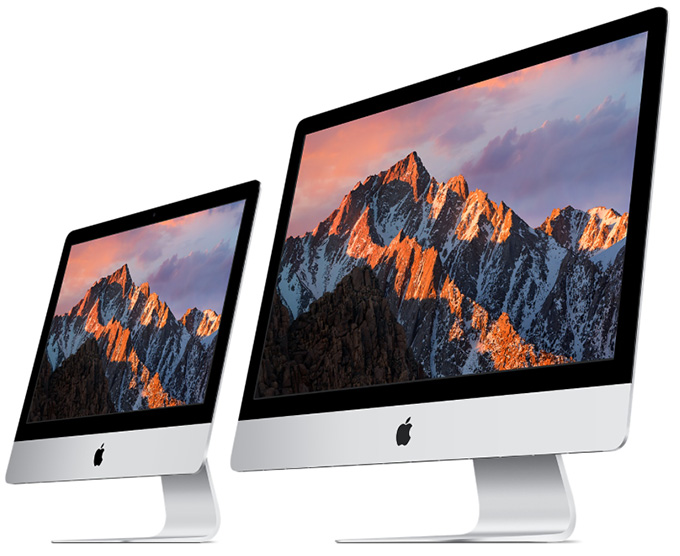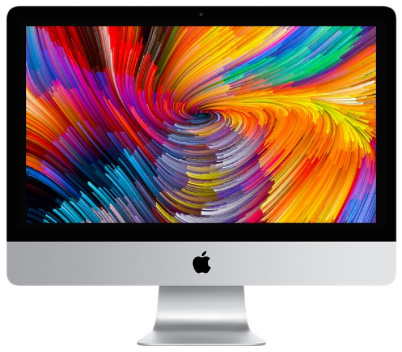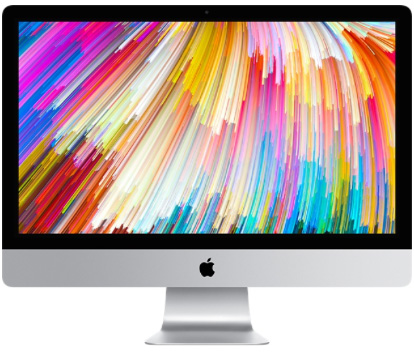 [ Update: On March 19, 2019, Apple released updates to both 21.5″ and 27″ iMacs. These new systems feature improved CPU and GPU options, though the display and storage remain the same as earlier versions. I’ve reflected these new options in my recommendations below. ]
[ Update: On March 19, 2019, Apple released updates to both 21.5″ and 27″ iMacs. These new systems feature improved CPU and GPU options, though the display and storage remain the same as earlier versions. I’ve reflected these new options in my recommendations below. ]
At their WWDC, in June, 2017, Apple announced and released new iMac computers, designed to meet the needs of professionals. These new systems sport a variety of very exciting features. However, if you are on a budget, how do you determine where to spend your money?
This article is designed to help you make more informed choices when you don’t have a lot of money to spend.
NOTE: I have not purchased any of these systems. My recommendations are based on past experience, current system specs and talking with informed individuals.
EXECUTIVE SUMMARY
If money is no object, buy the top of the line iMac. It will work great and you’ll have bragging rights over all the other systems.
But, if money IS an object, then you need to make trade-offs, balancing the performance you need with the money you have. However, you don’t need to spend a fortune to get a system today that can meet your editing needs for the next several years.
ALSO: Here are two other configuration articles you may find useful:
YES, BUT WHAT ABOUT THE IMAC PRO?

Holy smokes! What a system.
This review covers the iMac. Click here to read about the iMac Pro.
YES, BUT WHAT ABOUT THE MAC PRO?
Given the latest iMac releases, there are very, very few reasons to purchase a Mac Pro right now; especially given its price. Keep in mind, however, that Apple has already announced they are working on a new, top-of-the-line Mac Pro which will ship sometime in 2019.
Given what Apple has announced for the iMac Pro, however, that upcoming Mac Pro will need to be a true screamer to compete. I’m looking forward to seeing what Apple creates – but, as I mentioned earlier, I still need to pay my bills today.
And that leads us directly to the latest updates to the iMac.
WHAT SIZE SCREEN?

Both Final Cut Pro X and Premiere interfaces work best on larger screens. This is not to say they work poorly on smaller screens, but both of these display a LOT of elements on screen. More screen room is MUCH better.
I recommend a 27″ display. Plus, all the new 27″ iMacs now share the same 5K Retina Display.
NOTE: One of my iMacs is an older 5K iMac. I’ve discovered, that while seeing a 5K image is nice, the on-screen text is often very hard to read. So I’ve lowered the screen resolution using System Preferences to make the text larger. I prefer to easily read the text to seeing every pixel in my image.
However, if the purpose of the new system is video compression, you don’t need the bigger screen size. In which case, you can save money and improve performance with a 21″ system.
NOTE: Both H.264 and the up-coming H.265 video codecs are hardware-accelerated in all the new hardware. While this won’t help when transcoding into ProRes, hardware-acceleration will significantly speed compressing files for the web.
WHAT SPEED CPU?
UPDATE Intel’s latest 8th-gen and 9th-gen Core processors, including up to a 3.2GHz six-core 8th-gen Core i7 with Turbo Boost up to 4.6GHz for the 21.5-inch 4K iMac and up to a 3.6GHz eight-core 9th-gen Core i9 with Turbo Boost up to 5.0GHz for the 27-inch 5K iMac.
While CPU speed is important, it is not critical for video editing; remember, iMacs that were current as recently as last month, were easily able to edit almost all forms of SD, HD, and 4K media.
Any of the processors in any of the new iMacs will be fine for video or audio editing.
UPDATE: The choice in the 21.5″ iMac is between i5 and i7. The i7 is worth the money because of its support for multi-threading. The choice in the 27″ iMac is harder: between i5 and i9, because it’s a $500 differential. Unlike the i5, the i9 supports multithreading. If you are doing multicam, 4K or HDR editing, or lots of video compression, the i9 is worth the money.
HOW MUCH STORAGE?

I really like that Apple has put Fusion drives into all but two of their iMacs. I own two iMacs with Fusion drives and I remain very impressed with these systems. They are an excellent balance between the speed of an SSD with the storage capacity of spinning media.
Keep in mind that the SSD portion of a Fusion drive is only a part of the total storage. For example, the 1 TB Fusion uses a 32 GB SSD, while the 2 and 3 TB Fusion drives use a 128 GB SSD. The OS watches what you do and moves files onto the SSD based upon what you are using most. Which means that a Fusion drive works fastest with files you access over and over.
NOTE: Here is an updated article on storage speeds and media requirements that explains the load your storage system needs to carry.
If you want maximum performance AND you plan to store media on an external drive, get the 512 GB SSD. All the files in macOS will take less than 30 GB, leaving plenty of room for working files and immediate storage.
If you want an excellent balance between performance, price and capacity, stay with the 1 TB Fusion drive. Again, store media externally.
If you don’t plan to purchase external storage – and you will, you just don’t know it yet – get the 3 TB Fusion drive. (An extra TB for $100 makes this a better value than the 2 TB Fusion drive.)
One of my systems has a 3 TB Fusion drive. Currently, I’m using 600 GB of it. The rest is sitting around idle. When using external storage, you really don’t need lots of internal storage.
If you just want maximum performance from your storage, get the 1 TB SSD. It’s pricey, but it’s speed will make you giggle.
Apple notes: “For the best performance, iMac systems with 32GB or more of memory should be configured with a 2TB or larger Fusion Drive or all-SSD storage.”
NOTE: Apple’s marketing materials now define a terabyte as one trillion bytes. This means that when a disk is formatted, its storage capacity will be less than 1 TB because of the differences between how marketing and engineering calculate disk sizes.
WHICH GPU?
Configuring the GPU (Graphics Processing Unit) is now done when you pick the initial iMac, rather than as a build-to-order option within each iMac family. So, much though I would like to pick the mid-range system and add a high-end GPU into it, we no longer have that option.
Which is a shame. Because while we don’t need the high-end CPU system for most video editing, we would significantly benefit from the high-end 580 GPU in any system.
Both Final Cut and Premiere are increasingly using the GPU for most editing tasks, because the GPU is much faster than the CPU at rendering bitmapped images. Therefore, the best choice is the high-end GPU. The high-end GPU also includes 8 GB of video memory (VRAM).
However, the mid-range system with the Radeon Pro 575X is a perfectly adequate choice.
NOTE: The difference between the 575X and 580X is performance. The 575X has a peak performance of about 4.5 Teraflops, while the 580X supports up to 5.5 Tflops. Both will handle video just fine. All of the Radeon chips support OpenCL and Apple’s Metal and up-coming Metal 2 GPU computing API.
Here’s a link to learn more about Radeon’s GPU chips.
NOTE: Again, if you are principally doing video compression, the GPU speed is less important than the CPU speed. So, compressionists don’t need as high-performance a GPU as an editor.
UPDATE: When looking at GPU performance, use the specs for Metal or Metal II. OpenCL will not be supported going forward. Also, while eGPUs are attractive, I don’t see them, yet, as a big enough benefit for iMacs. eGPUs are principally designed for laptops.
HOW MUCH RAM?
Both Final Cut and Premiere will use as much RAM as you can afford.
Based on my tests with the 2016 MacBook Pro, I recommend a minimum of 16 GB of RAM, though, all my systems here have 32 GB. Again, if you have the money, max out the RAM. However, 32 GB of RAM will be sufficient for virtually all projects.

HOW MUCH SHOULD I SPEND?
You are going to be using this computer for four years. Spend what you can afford, but don’t be stingy in areas that matter: GPU and RAM.
All the base systems are fine, But, depending upon your needs, you can tweak the configurations to better match what you want the systems to do. All systems feature wireless mice and keyboards; though, in my office, I prefer my mice and keyboards wired.
NOTE: Apple has not yet delivered the Touch Bar on any stand-alone keyboards.
If it were my money and I was doing video editing on a budget, here’s what I would get:
Total: $2,499 (you’ll still need to spend additional money for 3rd-party RAM)
However, I wish that Apple made the Radeon 580X available on the mid-range unit.
If it were my money and I was doing mostly video compression, I’d get the high-end Mac mini. (This, in fact, is what I did personally.) Here’s an article that explains this in more detail.
As always, I’m interested in your opinions.
346 Responses to Configure a 2019 iMac for Video Editing [u]
Newer Comments →-
 Phillip says:
Phillip says:
June 12, 2017 at 7:46 am
-
 Larry says:
Larry says:
June 12, 2017 at 8:17 am
-
 Phillip says:
Phillip says:
June 12, 2017 at 7:53 am
-
 Larry says:
Larry says:
June 12, 2017 at 8:18 am
-
 Erwin says:
Erwin says:
June 12, 2017 at 9:43 am
-
 Larry says:
Larry says:
June 12, 2017 at 9:59 am
-
 Alex Stojkovic says:
Alex Stojkovic says:
June 14, 2017 at 1:57 am
-
 Larry says:
Larry says:
June 14, 2017 at 6:09 am
-
 Gord says:
Gord says:
June 14, 2017 at 4:03 am
-
 Larry says:
Larry says:
June 14, 2017 at 6:10 am
-
 Gord says:
Gord says:
June 14, 2017 at 6:54 am
-
 Larry says:
Larry says:
June 14, 2017 at 7:16 am
-
 George Knochel says:
George Knochel says:
June 14, 2017 at 9:27 am
-
 Larry says:
Larry says:
June 14, 2017 at 9:59 am
-
 J Rushton says:
J Rushton says:
June 15, 2017 at 11:17 am
-
 Larry says:
Larry says:
June 15, 2017 at 4:25 pm
-
 alex says:
alex says:
June 19, 2017 at 5:27 pm
-
 Larry says:
Larry says:
June 19, 2017 at 5:33 pm
-
 Charlie says:
Charlie says:
June 20, 2017 at 7:20 am
-
 Larry says:
Larry says:
June 20, 2017 at 7:34 am
-
 Tyrone says:
Tyrone says:
June 21, 2017 at 3:11 am
-
 Larry says:
Larry says:
June 21, 2017 at 9:36 am
-
 jmtweb says:
jmtweb says:
June 26, 2017 at 11:03 pm
-
 Larry says:
Larry says:
June 29, 2017 at 9:20 am
Newer Comments →Does this apply to After Effects work as well?
Phillip:
Essentially, yes.
Larry
would you stick with that same setup if you were also in and out of after effects?
Philip:
Yes. After Effects uses both the CPU and GPU and, money being no object, the high-end system would be the best. But, when you need to save money, I would follow the same guidelines for After Effects.
Larry
And what about the new upgraded Macbook Pro 15″ ?
Erwin:
For laptops, read this, it covers both 2016 and 2017 laptops:
https://larryjordan.com/articles/configuring-a-2016-macbook-pro-for-video-editing/
Larry
That is a very useful article. I am trying to get better at using Final Cut Pro to video for my business. I am currently using a 2015 Macbook Pro that only has Iris graphics and I need a major speed boost. Thinking of getting either a new iMac or waiting for the iMac Pro, but can’t really afford that so will go with the iMac I think. Anyway, I was wondering what do you recommend to use for external SSD hard drives that are pretty portable.
Alex:
Most SSDs are small and portable. You can buy individual drives, or drives with a dock, or RAIDs. Here’s a good one from OWC:
https://eshop.macsales.com/shop/Thunderbolt/External-Drive/OWC/ThunderBay-4-mini
Larry
Thanks for your help Larry. There are a lot of benchmark reviews out there but not a lot that focuses on video editing.
Our company has the budget for a mid-level 27 inch upgrade to i7. Do you think FCPX, Premiere, and AE will benefit from upgrading to i7? Would there be any enchancements to performance?
I’m currently on a late-2013 “15 MBP IrisPro Graphics with 8GB ram 256SSD. I’m already experiencing lags even with FCPX
Gord:
Any new computer will be faster than an older computer, so, yes, there would be a benefit. And the newest iMacs, released last week, would be a significant improvement on what you have.
Larry
Thanks for the helpful response
Do you recommend i5 or i7 trim? If it not worth the added price, I will stick with the base i5 model.
Gord:
As you read in the article, i7’s don’t exist with the current iteration of iMacs.
Larry
Yes, i7s do exist with the new iMacs.
Go to Apple.com, then click on iMac, then BUY at the top right of the window,
choose “Select” on the 27″ iMac 5K Retina, most expensive i5 model, and you’ll see the options that you can choose with it, like the i7 — 3.4GHz, 3.5GHz, or 3.8GHz quad-core Intel Core i5 or 4.2GHz quad-core Intel Core i7 processor
Turbo Boost up to 4.5GHz
George:
Ah, missed this when I was writing the article. Thanks for pointing this out.
If all you are doing is video editing, you won’t need the i7 – IF you are trying to save money.
Larry
I usually have a bunch of plugins that slow down rendering to an unbearable crawl. Noise reduction is a big culprit. I assume you would recommend the faster GPU for this, correct?
J:
You’ll need to contact the developer – it is not always correct to say that all plug-ins use the GPU. However, I have heard that video noise reduction can take a long time. The developer is the best source for optimization options.
Larry
just got the new imac maxed out with 64 gigs of ram, 1TB SSD i7 processor and a 48 TB thunderbolt 3 external raid 6 set up. I’m EXTREMELY underwhelmed with the performance in premiere. The benchmark test all look great. Fast read write speed from the drive, GPU seems like it cranks but 4k red playback is dodgy and it drops more frames than my old 6 core mac pro tower even at 1/2 res. I feel like something is terribly wrong or this machine is going back and i’m waiting for the pro.
Alex:
Even older iMacs have better performance than what you report. My GUESS is that either the GPU is overwhelmed, the wrong RED drivers are installed, or there is a hardware problem with your system.
I would contact Adobe Support.
larry
Great article. But I would always advocate buying the minimum amount of RAM from Apple. Their prices on RAM are obscene. Upgrade afterwards from a reputable sources like OWC you will save hundreds of dollars ($800 if you go with 64GB of RAM)
Charlie:
This is good advice – EXCEPT – most of these iMacs can not upgrade memory in the after market.
Larry
Would these recommendations you’ve made be applicable to using Avid Media Composer?
Tyrone:
Probably. I don’t know Avid as well as Premiere or Final Cut, and I don’t know how much Avid uses the GPU compared to the CPU.
It might be worthwhile to chat with Avid Support about this, then let me know what you find out.
Larry
Bonjour,
Merci pour la remontée d’informations.
Indépendamment du coût, j’ai lu sur certains forums que l’imac 27/i7 incluant la carte graphique 580 montait en température, 90° voir +.
Pour la pérennité du matériel, peut-être est-il préférable de choisir l’i5 avec la carte graphique 575 car la puce chauffe sensiblement moins, de 50° à 60°.
Il est important de prendre cet item en considération sachant que la température influe directement sur la durée de vie de ce type de technologie.
Cordialement,
jmtweb
JmtWeb:
For those that don’t speak French, here is your comment:
– – –
Thanks for the feedback.
Regardless of the cost, I read on some forums that the imac 27 / i7 including the 580 graphics card rose in temperature, 90 ° see +.
For the durability of the hardware, perhaps it is preferable to choose the i5 with the graphics card 575 because the chip heats significantly less, from 50 ° to 60 °.
It is important to take this into consideration as temperature directly influences the lifetime of this type of technology.
Regards,
– – –
My thinking is that Apple is very cognizant of heat and the need to prevent it from ruining components. If you are running a computer in a normal office or home, where temperatures are comfortable for humans, you should not have heat issues with the computer.
If you are taking it into extreme environments, then I would check with Apple Support to see what they recommend.
Larry